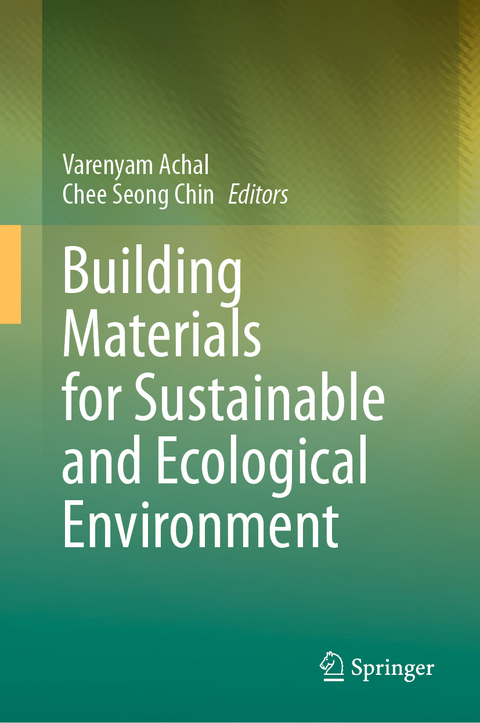
Building Materials for Sustainable and Ecological Environment
Springer Verlag, Singapore
978-981-16-1705-8 (ISBN)
The book is motivated by recent rapid advances in sustainable building materials production, including green building materials made ofindustrial by-products and recycled wastes, earth materials, plant-based materials, microbial-based materials or supplementary cementitious materials, to reduce the environmental impacts of traditional building materials. Discussing the development and applications of various sustainable building materials, including related case studies, and addressing the environmental issue with a holistic and systematic approach that creates an ecology of construction for sustainability in infrastructures, it offers promising solutions to achieve renewable and sustainable building materials for the future.
Professor Varenyam Achal is Professor in environmental engineering and Deputy Dean of Undergraduate Studies at Guangdong Technion – Israel Institute of Technology (GTIIT), Shantou, China. Prof. Achal was awarded a Ph.D. from Thapar University, India. Prior to joining GTIIT, he was Professor at East China Normal University, Shanghai. He has a very broad interest in environmental biotechnology and biological-based building materials. Some of his original research has had a global impact on microbially induced calcite precipitation and attracted worldwide attention. He has authored more than 100 research articles, book chapters, patent and technical reports. Earlier Prof. Achal has edited a book “Ecological Wisdom Inspired Restoration Engineering” published by Springer. Professor Chee Seong Chin is Dean of Learning and Teaching of Xi'an Jiaotong-Liverpool University, supporting the University in the operational delivery of its academic strategy and the ongoing coordination of learning and teaching. Professor Chin sits on the Senior Management Team Committee, Academic Strategy Group and Academic Board as well as chairs multiple University-level committees/boards/panels that are responsible for overseeing the general policies and practices related to learning and teaching. Professor Chin received his First-Class B.Eng. (Hons) and Ph.D. degrees in Civil Engineering from Swansea University, UK, and has more than 15 years of experience working in international higher education institutions. He is the Founding Director of the Institute for Sustainable Materials and Environment and Founding Head of the Centre for Advanced Fibre Reinforced Concrete Technology. He was previously Head of the Department of Civil Engineering. His primary research interests are fibre-reinforced cementitious composites as well as sustainable construction andbuilding materials. Professor Chin has acquired over 15 million RMB of research grants; produced more than 80 research articles, patents and technical reports; supervised 17 Ph.D. students for their dissertations; and founded/directed 5 academic programmes at undergraduate and postgraduate levels.
Chapter 1. The practical use of biocement as self-healing agent and in construction requires a socio-ecological approach.- Chapter 2. Utilisation of Biomineralisation Method in Recycled Coarse Aggregate Concrete with Fly Ash.- Chapter 3. Characterization and an overview of utilization and neutralization for efficient management of Bauxite residue for sustainable environment.- Chapter 4. The amendments in typical microbial induced soil stabilization by low-grade chemicals, biopolymers and other additives: A review.- Chapter 5. An Overview of Factors influencing Microbially Induced Carbonate Precipitation for its Field Implementation.- Chapter 6. Life Cycle Assessment of Concrete Masonry Units with Waste Paper Fibres.- Chapter 7. Soil pH and its Significance as Ecological Material: Perspectives and Implications.- Chapter 8. A review on coupled phenomena in aquifers from the perspective of geological storage of carbon dioxide with ecological significance.- Chapter 9. A review on role of enzymes and microbes in healing cracks in cementitious materials.- Chapter 10. A socio-ecological perspective on green urbanisation and urban ecological intensification.
| Erscheinungsdatum | 07.06.2021 |
|---|---|
| Zusatzinfo | 12 Illustrations, color; 28 Illustrations, black and white; X, 172 p. 40 illus., 12 illus. in color. |
| Verlagsort | Singapore |
| Sprache | englisch |
| Maße | 155 x 235 mm |
| Themenwelt | Naturwissenschaften ► Biologie ► Ökologie / Naturschutz |
| Naturwissenschaften ► Geowissenschaften | |
| Sozialwissenschaften ► Politik / Verwaltung | |
| Technik ► Architektur | |
| Technik ► Bauwesen | |
| Technik ► Umwelttechnik / Biotechnologie | |
| ISBN-10 | 981-16-1705-8 / 9811617058 |
| ISBN-13 | 978-981-16-1705-8 / 9789811617058 |
| Zustand | Neuware |
| Haben Sie eine Frage zum Produkt? |
aus dem Bereich


